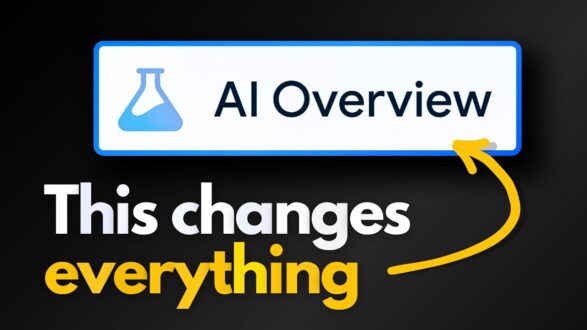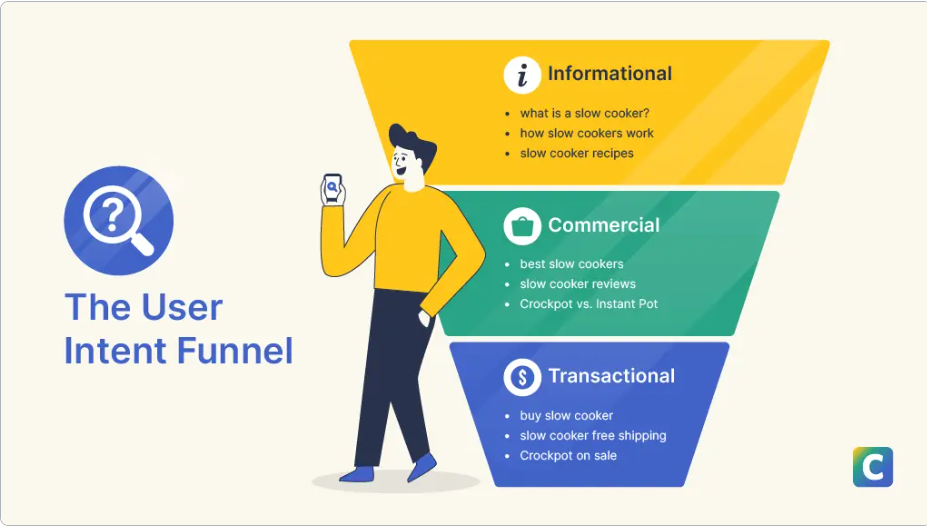This post describes Google’s transition from SEO to AI Overviews for content marketers and offers nine tips for smoothing your transition.
By way of background, the Streaming Learning Center is content-driven, and we’ve always tried to adhere to SEO best practices. Now that we are writing for other websites, our focus on SEO has become even more critical.
As you’ve probably heard, Google recently adopted AI Overviews (initially called Search Generative Experience, or SGE), which changes all the SEO-related rules. This article is a first pass on what we know about AI Overviews (or AIO for cool kids in the know) as of May 2024 and how to keep your content relevant.
The TL/DR message is this. SEO isn’t dead, but you should focus more on high-quality content than ever before. High volumes of low-quality content will drag you down in the search engine results, not improve your positioning.
Contents
Introduction
For years, Search Engine Optimization (SEO) has been the cornerstone of online success, helping businesses across various industries, including encoding and transcoding, to drive traffic and gain visibility. However, the advent of Search Generative Experience (SGE) and AI-generated overviews is changing how users find and interact with content online.
This article explores the implications of this significant shift for the encoding/transcoding industry. We explore the origins and functions of SGE and AI-generated overviews, examining their impact on traditional SEO strategies. Then, I share nine tips for industry players to adapt and thrive in this new era.
SEO in the Encoding/Transcoding Industry
Search Engine Optimization (SEO) has long been a critical tool for businesses in the encoding and transcoding industry to drive traffic and enhance visibility. SEO helps achieve this by improving a website’s ranking on search engine result pages (SERPs), making users more likely to visit the site. As we all know, SEO is crucial in attracting prospects, building brand awareness, and generating leads and conversions.
Traditional Keyword Optimization
To leverage the benefits of SEO, companies in the encoding and transcoding industry have traditionally employed multiple strategies, divided into two general categories:
- Substantive optimization – creating high-quality content of interest to prospects, like informative articles, guides, tutorials, and case studies.
- Tactical optimization – including keyword planning and optimization, backlink building, and guest posting.
By employing these traditional SEO strategies, organizations have enhanced their online presence. However, with the advent of SGE and AI-generated overviews, these strategies must be re-evaluated and adapted to remain effective.
Here’s what a search engine results page (SERP) used to look like.
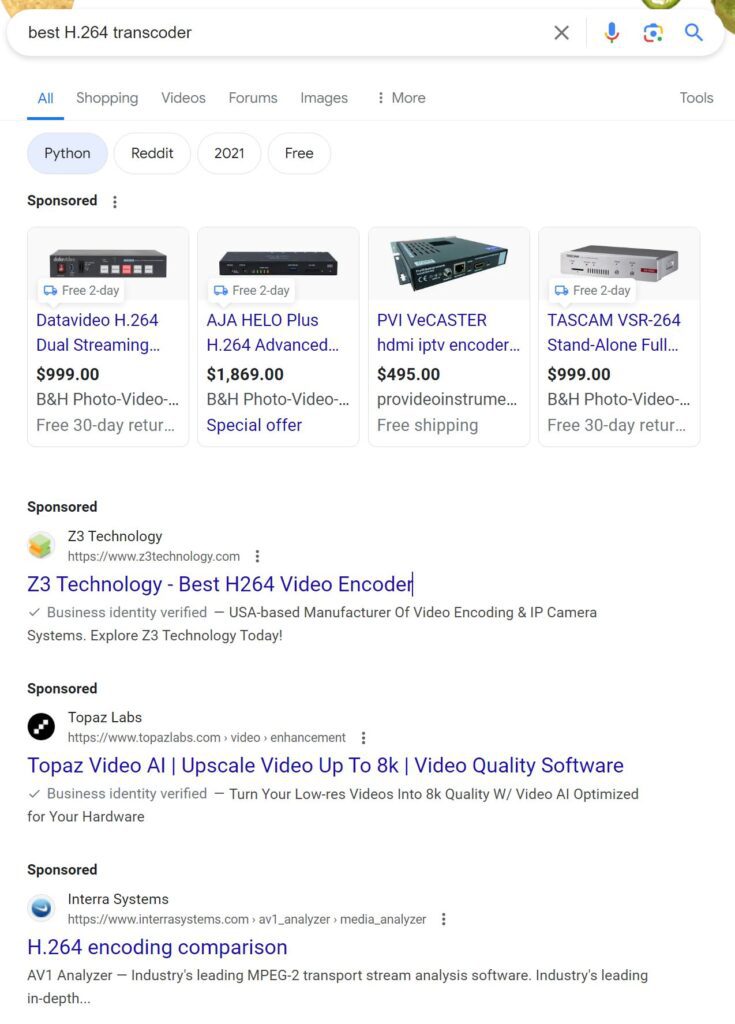
Emergence of Search Generative Experience (SGE)/ and AI-Generated Overviews (AIO)
Google started using AI to present summaries in what was originally called Search Generative Experience (SGE). Rather than simply supplying a number of links, Google supplied “an AI-powered snapshot of key information to consider, with links to dig deeper.” For more information, see this deep dive here.
Briefly, SGE leverages advanced artificial intelligence (AI) technologies to generate concise, informative overviews of search results. These AI-generated overviews aim to provide users with quick, accurate answers to their queries, summarizing the most relevant information from multiple sources. Instead of simply listing links to various websites, search engines employing SGE use AI algorithms to analyze and synthesize content, presenting users with a summary.
In the screenshot below, you see the AI overview below the top link.
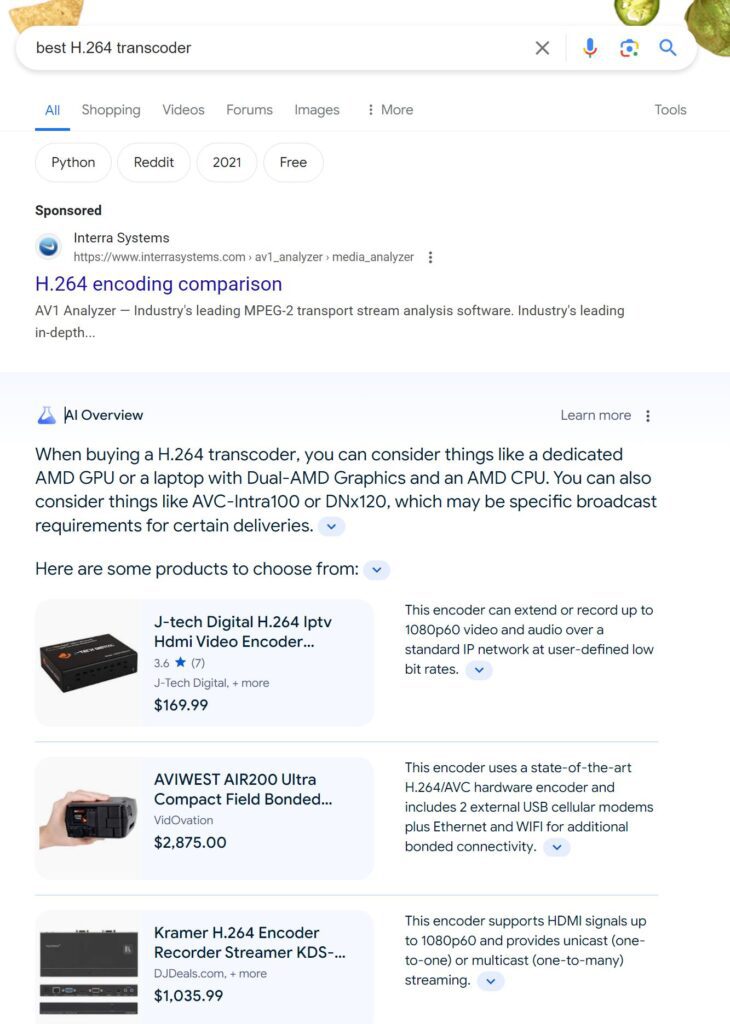
SGE became AI Overviews (or, AIO) at Google I/O in May 2024. Here’s the explanation from the Google Ads-Commerce blog, which found that the new feature actually improved the value of organic links.
AI Overviews will appear in search results when they’re particularly helpful beyond what Search offers today. With AI Overviews, people are visiting a greater diversity of websites for help with more complex questions; we also see that the links included in AI Overviews get more clicks than if the page had appeared as a traditional web listing for that query. In fact, we’ve found that people who use AI Overviews actually use Search more and are more satisfied with their results. And when people click to links from AI Overviews, these clicks are higher quality, where users are more likely to spend more time on the site. As we continue to test and evolve the Search experience, we’ll remain focused on sending valuable traffic to publishers and creators.
Note that Google doesn’t supply AI Overviews for all queries; this article found AI Overviews on only 15% of queries. This will likely change over the next few months, but this is where we are in May 2024.
This video does a nice job summarizing the recent changes from what Google called SGE (Search Generative Experience) to AI-Generated Overviews, or AI Overviews.
What’s the long-term impact on click throughs? No one knows. We do know (to paraphrase Terrell Owens) that Google has 46 billion reasons to continue to support web advertising and that organic search items continue to play role in the AI Overview schema. So, consider what I present below to be the best advice from the sources I consulted, but a definite work in process.
Tips for Transitioning to AI Overview
All that said, here are nine things to understand to keep your website relevant for AI-generated overviews.
1. Recognize That What Got You Here Won’t Keep You Here
As noted here, “43% of Google SGE sources don’t rank in “old Google” at all for the given query.” As the article continued,
Undoubtedly, Google SGE is powered by a completely new and different algorithm that has little to do with the good old Google. In other words, your existing rankings don’t guarantee you’ll thrive as the SGE user base grows. However, our data shows that if you’re ranking in the top 10 for a given query, your odds of being used as an SGE source are better than if your ranking is lower.
The phrase “if you ain’t cheating, you ain’t trying” has been attributed to everyone from NASCAR drivers to Navy Seals. The corollary here is that “if you ain’t changing, you ain’t trying.” The bottom line is that AI Overviews is a blank slate. Currently successful SEO marketers have everything to lose, while everyone else has everything to gain.
Action Steps:
- Regularly review and update your SEO strategy to align with current trends.
- Invest in ongoing education and training for your team.
- Experiment with new content formats and optimization techniques.
2. Create High-Quality, In-Depth Content
Let’s face it; for many sites, the lure of AI-generated content produced a mass of high-volume, low-value content. Whether that was ever effective is doubtful, but it certainly isn’t now. As stated here, “Google’s automated ranking systems are designed to present helpful, reliable information that’s primarily created to benefit people, not to gain search engine rankings, in the top search results.”
In terms of quality, Google urges content creators to “self-assess” their content and ask some of these questions.
- Does the content provide original information, reporting, research, or analysis?
- Does the content provide a substantial, complete, or comprehensive description of the topic?
- Does the content provide insightful analysis or interesting information that is beyond the obvious?
- If the content draws on other sources, does it avoid simply copying or rewriting those sources, and instead provide substantial additional value and originality?
- Is the content produced well, or does it appear sloppy or hastily produced?
If you’re seeking to achieve yes answers to most of these questions, this article presents the following useful list.
So, quality content should:
- Satisfy user intent—provide the information or solution the user is seeking (more later)
- Provide original information, research, or analysis
- Reflect the creator’s expertise and first-hand experience on the subject
- Be relevant and comprehensive enough to answer users’ questions effectively
- Offer substantial value compared to other pages
We’ve all used AI to help produce our articles, but few primarily AI-generated blogs or articles trigger a yes answer to all or even a majority of these questions. In the AI-driven search landscape, one well-crafted article can be more impactful than multiple mediocre ones.
Note that Google considers the user experience when evaluating content quality. Factors like bounce rate, time on page, and interaction rates inform Google whether your content is considered useful by those who consume it.
Action Steps:
- Conduct thorough research to gather accurate and comprehensive information.
- Write clear, concise, and engaging content that directly addresses user queries.
- Regularly update content to keep it current and relevant.
3. Leverage Video Content
71% of AI Overview results analyzed contained a YouTube video, highlighting the importance of video content. Videos can enhance engagement and increase the likelihood of being featured in AI Overviews.
Action Steps:
- Create informative and high-quality videos that complement your written content.
- Optimize video titles, descriptions, and tags for SEO.
- Embed videos within relevant content on your website.
4. Use Structured Data
Structured data helps search engines understand the context of your content, which can improve your chances of being featured in AI overviews. Even if you use website builders like Wix or WordPress, you should ensure your structured data is correctly implemented.
Action Steps:
- Add Schema Markup: Utilize built-in features or plugins like Yoast SEO for WordPress or the SEO Wiz for Wix to add schema markup to your site. These tools support various schema types and make implementation straightforward.
- Use JSON-LD Format: JSON-LD is the preferred format for structured data integration because it is easily read by search engines and can be implemented without affecting the HTML structure. Both Wix and WordPress support JSON-LD through their respective tools.
- Mark Up Key Elements: Ensure that key elements such as articles, reviews, and events are properly marked up. Customizing schema markup for specific content types can give you an edge in AI-generated overviews. In WordPress, plugins like Schema Pro can help, while Wix users can use the structured data options available in the SEO settings.
- Validate Structured Data: Regularly use Google’s Structured Data Testing Tool to check for errors in your markup. Even with Wix or WordPress, automated tools can miss updates or make mistakes, so validation is crucial.
- Monitor Performance: Use analytics tools to track how structured data impacts your search visibility. This helps you understand its effectiveness and make necessary adjustments to maintain relevance. Wix and WordPress offer analytics integrations to help you monitor these metrics.
By effectively using structured data, you can enhance how search engines interpret your content, increasing the likelihood of being featured in AI-generated overviews. While website builders like Wix and WordPress simplify the process, taking the time to ensure your structured data is correctly implemented and customized for your content remains vital.
5. Answer Specific Questions/Target Long-Tail Keywords
AI Overviews often respond to longer, more natural language queries, requiring a focus on long-tail keywords and conversational language. Creating content that answers specific questions can align with AI-driven search behaviors.
Another way to think of this is to target long-tail keywords. You may never rank for “H.264 transcoder,” but you might for “H.264 transcoder for cloud gaming.”
Action Steps:
- Identify common questions in your niche using tools like AnswerThePublic.
- Create content that provides clear and concise answers to these questions.
- Use natural language and conversational tone in your content.
6. Build E-E-A-T (Experience, Expertise, Authoritativeness, Trustworthiness) for your authors
Briefly,
- Experience: Demonstrates practical knowledge and skills gained through direct involvement in a particular field or activity.
- Expertise: Indicates a high level of knowledge or skill in a specific area, often supported by credentials or significant achievements.
- Authoritativeness: Refers to recognition as a leading source of information on a particular topic.
- Trustworthiness: Relates to the reliability and integrity of the content and its source, providing accurate and honest information.
The best advice I saw was from this article, which recommended, “This does not mean Google is credentialing people in your organization, but rather they are looking to see if you have built a clear path for users to understand why someone is an authority. They want to see the breadth of that individual’s contributions and expertise around a certain topic within the index.”
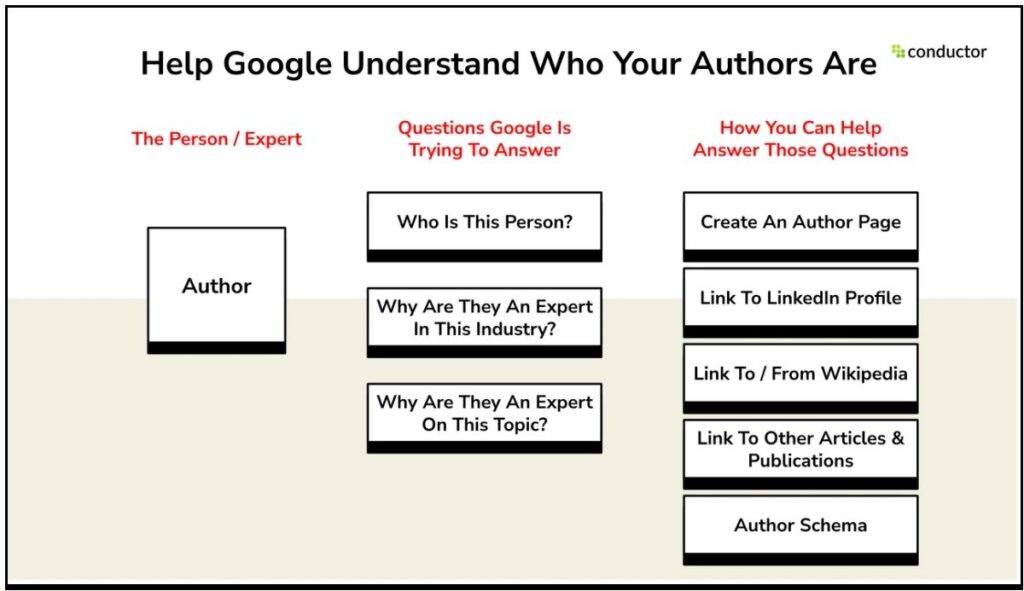
Demonstrating E-E-A-T is crucial for content to be considered credible and authoritative by AI Overviews.
Action Steps:
- Connect content to credible, authoritative individuals within your organization.
- Include author bios and credentials in your content.
- Cite reliable sources and provide accurate information.
7. Write to Satisfy User Intent (or Search Intent)
Prioritizing user intent (what the user is looking for with the query) guarantees that content is relevant and customized to user needs, improving rankings and traffic. As defined here, there are four types of user intent, also called search intent.
- Navigational intent: Users want to find a specific page (e.g., “where is the H.264 spec?”)
- Informational intent: Users want to learn more about something (e.g., “what is H.264”)
- Commercial intent: Users want to do research before making a purchase decision (e.g., “what’s the best H.264 encoder?”)
- Transactional intent: Users want to complete a specific action, usually a purchase (e.g., “Where to buy the best H.264 encoder”)
Figure 4. User intent is the underlying goal behind a search query. This shows where search intent fits into the sales funnel.
Understanding user intent helps create content that meets user expectations. For example, if the intent is transactional, sending the searcher to a page with lots of background information presents useless clutter that may negate the sale. Conversely, if the goal is informational, a minimalist landing page with buying information and little else will produce a quick bounce that will signal to Google that the page has low value.
The bottom line is that if you optimize a page for a given keyword, you should understand the buyer’s intent for that search and make sure your page directly matches and fulfills that intent. There are multiple tools for identifying the user intent behind a query, including from Semrush, ahrefs, SurferSEO, Keyword Insights, and AnswerThePublic.
Action Steps:
- Analyze keywords to ascertain their underlying intent using AI tools.
- Create content that aligns with what users are seeking.
- Use personalization techniques to tailor content to individual user preferences.
Check out this video for more on Search Intent.
8. Incorporate multimedia elements besides video
Use images, videos, and infographics to make your content more engaging and easier for AI to analyze and present. Multimedia elements enhance user experience and content visibility.
Action Steps:
- Integrate high-quality images, videos, and infographics into your content.
- Optimize multimedia elements for SEO using alt text, captions, and descriptions.
- Regularly update and refresh multimedia content to keep it relevant.
9. Monitor and Adapt to AI Overviews
Continuous monitoring of content performance is crucial in the AI Overview era. Regularly tracking and adjusting strategies based on data and user feedback can help maintain visibility.
Action Steps:
- Use analytics tools to track content performance and user engagement.
- Adjust your content strategy based on performance data and user feedback.
- Stay informed about updates and changes in AI technologies.
Implementing these strategies can help you manage the transition from traditional SEO to AI-generated overviews, ensuring your content remains visible and relevant.
We’re monitoring this transition to AI Overviews for our own content and for content created for our customers. Check out the writing services available from the Streaming Learning Center here.
 Streaming Learning Center Where Streaming Professionals Learn to Excel
Streaming Learning Center Where Streaming Professionals Learn to Excel

